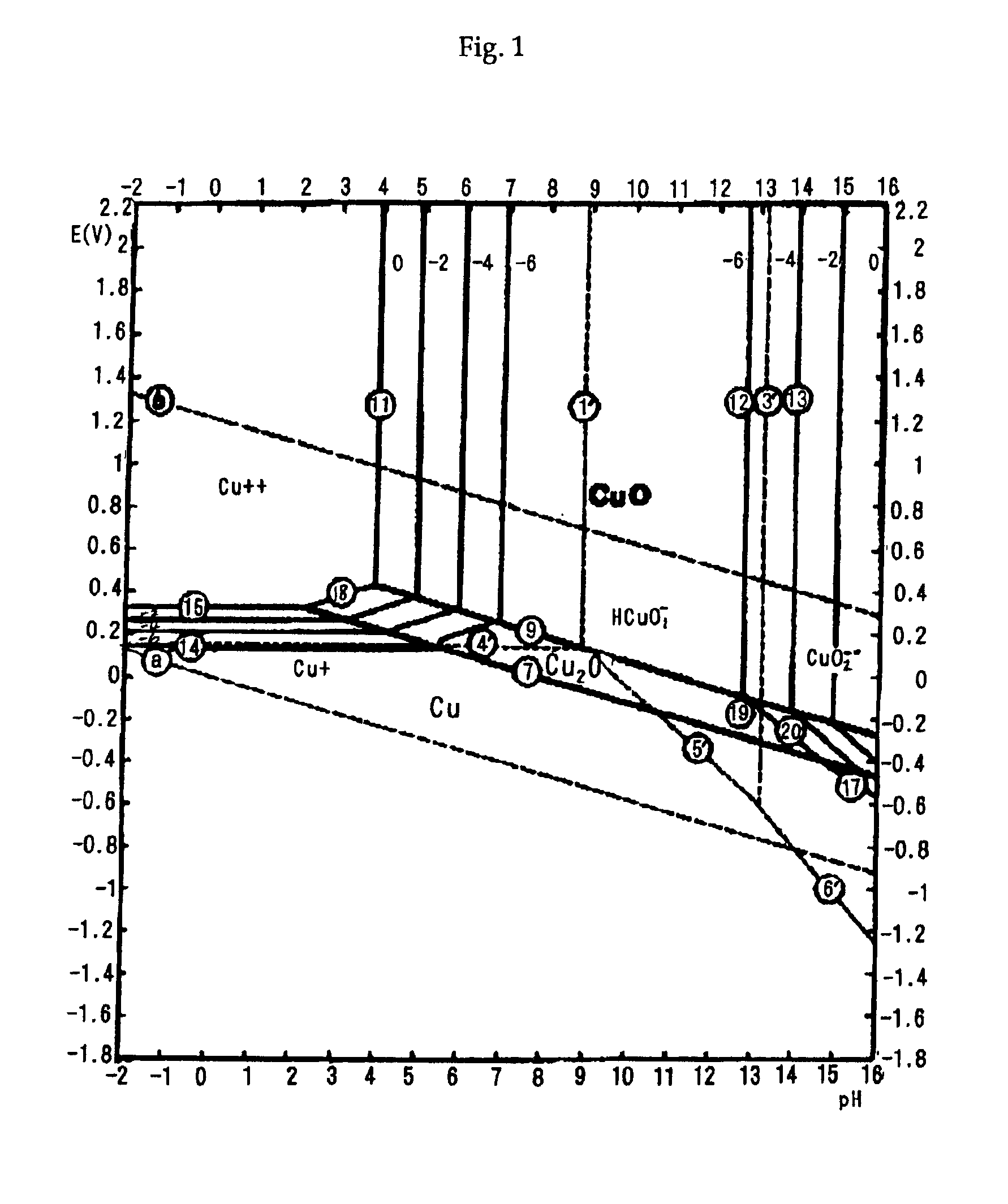However, the photoresist residues which remain after
dry etching cannot be completely removed with the photoresist stripping liquids generally used in the prior art which combine an
organic solvent with
alkanolamine (e.g., JP, A, 5-281753; U.S. Pat. No. 5,480,585).
However, these removing liquids for photoresist residues, if any thereof remains, corrode the wiring material; therefore, it is necessary to rinse with an
organic solvent such as
isopropyl alcohol etc. and to perform the treatment at a high temperature to remove the photoresist residues completely.
Moreover, because the liquids include organic compounds at a ratio of some 10% to 100%, these removing liquids for photoresist residues are a heavy burden on the environment and therefore not desirable.
Further, the wiring material is also corroded when the photoresist residues are removed, because the wiring material and the photoresist residues are similar composition.
This removing liquid does not contain organic solvents, which means that the burden on the environment is small, and it can be used without corroding metallic wiring of Al—Si—Cu, Al—Cu, W, Ti,
TiN, etc., However, together with the
miniaturization of the wiring that has been taking place in recent years,
etching and
ashing conditions have become more severe and
resist residues have come to be more firmly attached.
Therefore, treatments at high temperatures and for long durations are necessary to completely remove
resist residues, as a result of which Al—Si—Cu and Al—Cu have at times been corroded.
However, together with the
miniaturization of semiconductor circuit elements that has been taking place in recent years, a high degree of accuracy is being required for forming wiring and via-holes; therefore, dislocations between the wiring and the position of the via-holes, not matching completely, occur and with the via-holes not completely covered,
tungsten or other embedded metals may be exposed by the side of the upper wiring.
When using the above-mentioned strongly alkaline removing liquids for
resist residues containing
hydroxylamine or quarternary
ammonium compounds for removing these resist residues, there is the problem that the
tungsten is dissolved due to an electrochemical reaction.
However, when the resist residue removing properties are insufficient, it is necessary to add a surfactant, in which case there is the environmental burden to be considered because of the
phosphate compounds.
On the other hand, new wiring materials and interlayer insulating film materials have come to be used together with the increase in performance and the
miniaturization of semiconductor circuit elements that has been taking place in recent years, the result of which has been that limits have appeared in the way the removing liquids for photoresist residues of the prior art have hitherto been used.
As resist stripping liquid for this new wiring material, i.e., Cu wiring material, there are stripping liquids containing
triazole compounds as Cu
corrosion inhibitor (JP, A, 2001-22095; JP, A, 2001-22096; JP, A, 2000-162788); however, these stripping liquids, in the same way as described above, have to be used at high temperatures, need to be rinsed with
isopropyl alcohol etc. and also present the problem of containing organic solvents.
Further, there is also a resist stripping liquid composition comprising
benzotriazole derivatives as Cu
corrosion inhibiting agents (JP, A, 2001-83712); however, this composition also comprises an aqueous
organic solvent and involves the above-mentioned problems.
Moreover, since
triazole compounds and
benzotriazole derivatives do not easily dissolve in water, these
corrosion inhibiting agents remain on the
wafer surface after rinsing with water, which can have a negative effect on subsequent work processes.
Further, compared to conventional wiring materials and interlayer insulating film materials, Cu and different types of low-k films have a poor
chemical resistance; hence, it is not possible to use conventional photoresist residue removing liquids for aluminum wiring as they are to remove the photoresist residues remaining after dry
etching.
It is further desirable to remove the photoresist at low temperatures because the low-k films have a poor
chemical resistance.
Thus, various corrosion inhibiting agents for these
new materials have been considered, without, however, obtaining any satisfactory results up to now, as there are no acidic removing liquids with sufficient corrosion inhibiting effect which do not have a negative effect on the environment.
 Login to View More
Login to View More 
